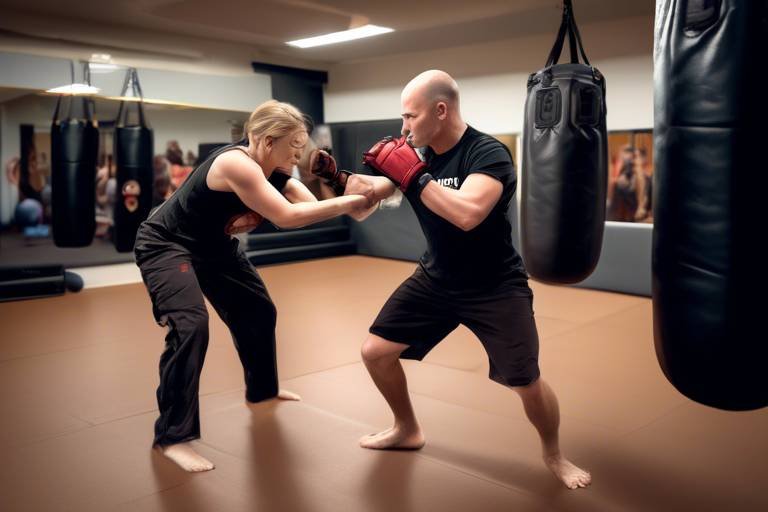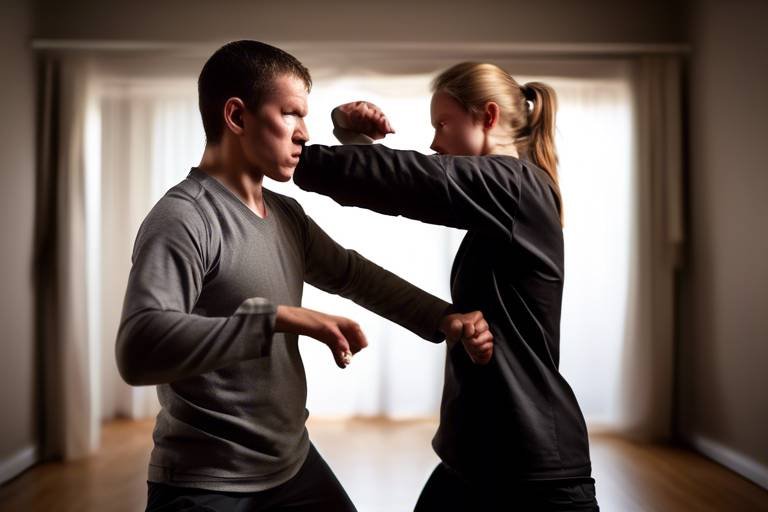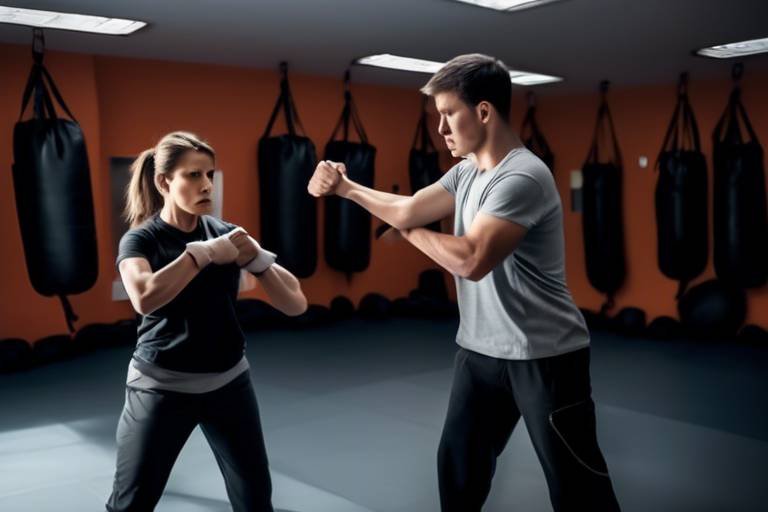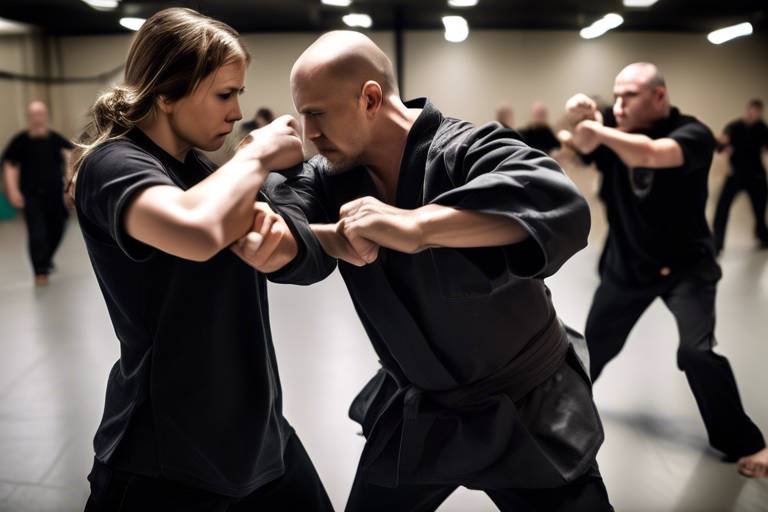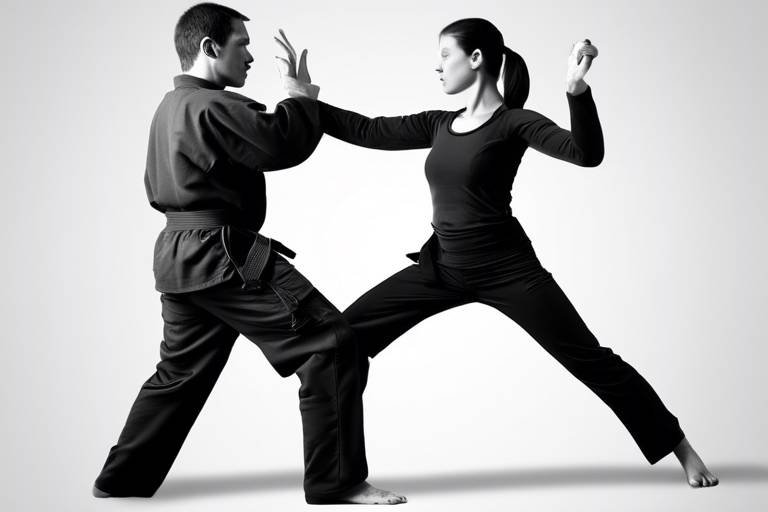Is Cardio a Key Factor in Self-Defense Training?
When it comes to self-defense training, many people often focus solely on techniques, strength, and agility. However, cardiovascular fitness plays a crucial role that is often overlooked. Imagine being in a high-stress situation where your heart is racing, your breath is quickening, and you need to react swiftly. Wouldn't it be better if your body was conditioned to handle that stress? This article dives deep into the relationship between cardiovascular fitness and self-defense training, highlighting how endurance can enhance performance, improve reaction times, and increase overall effectiveness in self-defense situations.
Think about it: if you're out of breath and fatigued, your ability to defend yourself diminishes significantly. Cardiovascular fitness is not just about running marathons or cycling long distances; it's about building the stamina to keep going when the going gets tough. In a self-defense scenario, whether it’s a sudden confrontation or a prolonged struggle, having the endurance to maintain your performance can make all the difference. This article will explore how enhancing your cardiovascular fitness can lead to better outcomes in self-defense situations.
Furthermore, the connection between cardio and self-defense extends beyond just physical capabilities. It's also about mental preparedness. Engaging in regular cardiovascular exercise can bolster your confidence, sharpen your focus, and help you maintain composure under pressure. In essence, cardio training is not just a physical endeavor; it’s a holistic approach to preparing oneself for the unexpected challenges of real-life confrontations.
As we delve deeper into this topic, we will examine the physiological benefits of cardiovascular training, explore different types of cardio workouts, and discuss practical ways to integrate cardio into your self-defense routine. By the end of this article, you will have a comprehensive understanding of why cardio is not just an accessory but a key factor in effective self-defense training.
Understanding cardiovascular fitness is crucial for self-defense training, as it directly impacts stamina, recovery, and the ability to perform techniques under stress during confrontational scenarios. When your heart and lungs are conditioned, you can engage in physical activities for longer periods without succumbing to fatigue. This endurance allows you to execute techniques effectively, even when you’re feeling overwhelmed.
Cardiovascular training can significantly improve your reaction times, allowing individuals to respond more quickly to threats. When your body is accustomed to high levels of exertion, your nervous system becomes more efficient, leading to faster reflexes and better decision-making in self-defense situations. For instance, a well-conditioned athlete can often react to an opponent’s moves with lightning speed, whereas someone who lacks cardiovascular fitness may find themselves a step behind.
Different types of cardiovascular workouts can be integrated into self-defense training. Here are a few examples:
- Running: Great for building overall endurance.
- Cycling: Excellent for leg strength and stamina.
- Interval Training: Boosts both aerobic and anaerobic fitness.
Each of these workouts has specific benefits that can complement your self-defense training, making it essential to find a routine that works for you.
HIIT is particularly effective for self-defense training as it mimics the burst of energy required in real-life confrontations. This training method involves short, intense bursts of exercise followed by brief rest periods. For example, you might sprint for 30 seconds, followed by a 30-second walk. This not only improves your cardiovascular fitness but also prepares you for the unpredictable nature of self-defense situations.
Steady-state cardio, such as jogging or swimming, builds endurance over longer periods. This type of training helps improve your aerobic capacity, allowing you to maintain your energy levels during prolonged physical encounters. It's a great way to develop a solid fitness foundation that can support more intense training as you progress.
Engaging in cardiovascular exercise not only improves physical fitness but also enhances mental resilience. The psychological benefits of cardio for self-defense practitioners are immense. Regular cardio workouts can help reduce anxiety, improve mood, and increase overall mental toughness. When faced with a threatening situation, a strong mind can be just as important as a strong body.
This section provides practical tips on how to effectively incorporate cardiovascular training into self-defense routines, ensuring a balanced approach that enhances both skills and fitness. A well-rounded program that includes both cardio and self-defense techniques will prepare you to face any situation with confidence.
Developing a training schedule that includes both cardio and self-defense techniques is essential. Aim to dedicate specific days to cardio workouts while also incorporating self-defense practice. For example, you might run or cycle on Mondays, Wednesdays, and Fridays, reserving Tuesdays and Thursdays for self-defense drills. This balanced approach ensures you’re not neglecting either aspect of your training.
Monitoring progress in cardiovascular fitness is vital for continued improvement. Consider keeping a workout journal or using fitness apps to track your routines and progress. As you become fitter, don’t hesitate to adapt your training programs to include more challenging workouts or longer durations. This adaptability is key to achieving your self-defense and fitness goals.
Q: How often should I incorporate cardio into my self-defense training?
A: Aim for at least 3-4 cardio sessions per week, alongside your self-defense practice.
Q: Can I do cardio on the same day as self-defense training?
A: Yes, but consider the intensity of both workouts. It may be beneficial to separate them by a few hours or do one in the morning and the other in the evening.
Q: What type of cardio is best for self-defense?
A: A mix of HIIT and steady-state cardio is ideal, as it builds both endurance and explosive power.

The Importance of Cardiovascular Fitness
When it comes to self-defense training, cardiovascular fitness is often the unsung hero. Think of it as the engine that powers your body during those critical moments of confrontation. Just like a car needs a robust engine to accelerate quickly, your body requires cardiovascular endurance to perform at its best when it matters most. Without adequate stamina, even the most skilled techniques can falter under the stress of an attack.
Imagine being in a situation where you need to react quickly; your heart is racing, and adrenaline is pumping. If your cardiovascular fitness is lacking, you might find yourself gasping for breath or unable to execute those crucial self-defense moves. This is why understanding the significance of cardiovascular fitness is vital. It not only enhances your ability to fight but also plays a pivotal role in your recovery and overall performance.
Engaging in regular cardiovascular exercise can lead to numerous benefits that are essential for self-defense practitioners:
- Increased Stamina: The longer you can maintain your energy levels, the more effective you will be in a self-defense situation.
- Improved Recovery: A well-conditioned cardiovascular system allows for quicker recovery between bouts of exertion.
- Enhanced Performance Under Stress: Being fit means your body can handle stress better, allowing you to think clearly and act decisively.
Cardiovascular fitness is not just about running marathons or cycling for hours; it's about preparing your body to handle the unexpected. In a self-defense scenario, your heart rate may spike, and your body will need to respond quickly. A strong cardiovascular base means you can maintain control, focus, and execute your techniques without succumbing to fatigue. Just as a soldier trains for battle, self-defense practitioners must also condition their bodies to withstand the rigors of a confrontation.
Furthermore, cardiovascular fitness contributes to a healthier lifestyle overall. It can help reduce stress, improve mood, and increase mental clarity—all of which are invaluable when facing a potential threat. In essence, investing time in cardiovascular training is investing in your ability to protect yourself and stay safe.

How Cardio Enhances Reaction Time
When it comes to self-defense, every second counts. Imagine being faced with a sudden threat; your ability to react swiftly can mean the difference between safety and danger. This is where cardiovascular fitness steps in as a game changer. Engaging in regular cardio workouts doesn't just build endurance; it also fine-tunes your body's response mechanism, enabling you to react more quickly and effectively in high-pressure situations.
So, how exactly does cardio enhance reaction time? First, let's talk about the physiological changes that occur when you engage in cardiovascular training. As you push your heart rate up during exercises like running, cycling, or swimming, your body undergoes a series of adaptations. These adaptations include improved blood flow, increased oxygen delivery to muscles, and enhanced neural pathways that facilitate quicker responses. Essentially, your body becomes a finely tuned machine, ready to spring into action at a moment's notice.
Moreover, cardio training boosts your overall stamina, which is crucial during prolonged confrontations. Think of it this way: if you're physically exhausted, your cognitive functions can take a hit, leading to slower reaction times. On the other hand, a well-conditioned body allows you to maintain focus and clarity, even when adrenaline is pumping through your veins. This means that not only can you react faster, but you can also make better decisions in the heat of the moment.
Additionally, engaging in cardiovascular workouts can enhance your mental agility. Studies have shown that aerobic exercise increases the production of brain-derived neurotrophic factor (BDNF), a protein that supports neuron growth and improves brain function. This translates to quicker reflexes and sharper decision-making skills, both of which are vital in self-defense scenarios. When your brain is firing on all cylinders, you're more likely to notice potential threats sooner and respond accordingly.
To illustrate the connection between cardio and reaction time, consider the following table that outlines the key benefits of cardiovascular training:
| Benefit | Description |
|---|---|
| Improved Blood Flow | Enhances oxygen delivery to muscles, allowing for quicker responses. |
| Increased Stamina | Helps maintain focus and energy during prolonged confrontations. |
| Enhanced Neural Pathways | Facilitates faster reflexes and decision-making under stress. |
| Mental Agility | Boosts cognitive functions, allowing for better threat assessment. |
In summary, incorporating cardiovascular training into your self-defense routine is not just beneficial; it’s essential. Whether you’re sprinting to escape a threat or grappling with an assailant, the enhancements in your reaction time can significantly improve your chances of staying safe. So, the next time you lace up your running shoes, remember that you're not just working on your endurance; you're also sharpening your instincts and preparing your body to respond when it matters most.
- How often should I do cardio for self-defense training? Aim for at least 3-4 times a week, mixing different types of cardio for optimal benefits.
- Can I do cardio on the same day as self-defense training? Yes, but ensure you balance the intensity and duration to avoid fatigue during self-defense practice.
- What type of cardio is best for improving reaction time? High-Intensity Interval Training (HIIT) is particularly effective, as it mimics the bursts of energy needed in real-life confrontations.

Types of Cardio Workouts
When it comes to enhancing your self-defense capabilities, understanding the different is essential. Not all cardio is created equal, and each type offers unique benefits that can help you not just in the gym, but also in real-life confrontational situations. Think of cardio as the fuel for your self-defense engine; without it, you might find yourself sputtering when it matters most. In this section, we’ll explore a few popular cardio workouts and how they can be seamlessly integrated into your self-defense training regimen.
First up, we have running. This classic cardio workout is fantastic for building endurance and stamina. Whether you prefer hitting the pavement or the treadmill, running can significantly improve your cardiovascular fitness. The beauty of running is that it can be tailored to your needs, whether you're sprinting for short bursts or going for a long, steady jog. Plus, it’s a great way to clear your mind and focus on your goals. Imagine yourself running away from danger—having the endurance to keep going can be a life-saver!
Next on the list is cycling. Whether you opt for a stationary bike or take your ride outdoors, cycling offers a low-impact way to boost your heart rate and strengthen your legs. The repetitive motion of pedaling not only builds muscle but also enhances your cardiovascular system. Cycling can help improve your leg strength, which is crucial when executing powerful kicks or maintaining balance during self-defense maneuvers. Picture yourself cycling through a park, feeling the wind against your face; it’s not just a workout, it’s a refreshing escape!
Another effective method is High-Intensity Interval Training (HIIT). This workout style alternates between short bursts of intense activity and periods of rest or lower-intensity exercise. HIIT is particularly beneficial for self-defense training because it mimics the explosive energy demands of a real confrontation. For example, you might sprint for 30 seconds, then walk for a minute, repeating this cycle several times. This approach not only builds endurance but also improves your body's ability to recover quickly—an essential skill when you're faced with an unexpected threat.
Finally, we can't overlook steady-state cardio, which includes activities like jogging or swimming at a consistent pace. Steady-state cardio is excellent for building endurance over longer durations, making it a perfect complement to the more intense training methods. It allows you to maintain a steady heart rate, enhancing your aerobic capacity. Imagine yourself swimming laps in a pool; it’s not only refreshing but also a fantastic way to build the stamina you'll need in a self-defense scenario.
In summary, integrating a variety of cardio workouts into your self-defense training can significantly enhance your overall performance. Each type of cardio offers unique benefits that contribute to improved stamina, reaction times, and mental preparedness. By mixing things up, you’ll keep your workouts fresh and exciting, which is crucial for maintaining motivation. So, lace up those shoes, hop on that bike, or dive into the pool—your self-defense skills will thank you!

High-Intensity Interval Training (HIIT)
High-Intensity Interval Training, or HIIT, has taken the fitness world by storm, and for good reason! This training method is not just a fad; it’s a powerhouse approach that can dramatically enhance your self-defense capabilities. Imagine this: you’re in a high-pressure situation, and your heart is racing, adrenaline is pumping, and every second counts. HIIT mimics this very scenario, allowing you to train your body to respond effectively under stress.
So, what exactly is HIIT? In essence, it involves short bursts of intense exercise followed by periods of rest or lower-intensity exercise. This pattern not only boosts your cardiovascular fitness but also improves your anaerobic capacity, which is crucial for self-defense. When you engage in HIIT, you’re training your body to recover quickly, a vital skill when facing unexpected threats. Think of it as a rollercoaster ride: the sudden climbs and drops simulate the unpredictable nature of real-life confrontations.
Incorporating HIIT into your self-defense training can be both fun and effective. Here’s how you can do it:
- Choose Your Exercises: Select a mix of bodyweight exercises, like burpees, jumping jacks, or even shadowboxing, combined with short sprints or cycling.
- Set Your Intervals: A common ratio is 30 seconds of all-out effort followed by 30 seconds of rest, though you can adjust this based on your fitness level.
- Frequency: Aim for 2-3 HIIT sessions per week, allowing your body time to recover between sessions.
One of the best things about HIIT is its adaptability. Whether you’re at home, in a gym, or outdoors, you can create a HIIT workout that fits your environment. The beauty lies in its flexibility; you can modify the intensity to suit your current fitness level. For instance, a beginner might opt for less intense exercises or longer rest periods, while an advanced practitioner can push the limits with complex movements and shorter breaks.
Moreover, HIIT not only builds physical endurance but also mental toughness. Each session challenges you to push through discomfort, developing resilience that can be beneficial in self-defense situations. When faced with a threat, the mental fortitude gained from HIIT can make a significant difference in your ability to stay calm and focused.
In summary, incorporating HIIT into your self-defense training routine can elevate your performance, enhance your reaction times, and prepare you both physically and mentally for unexpected confrontations. So why not give it a shot? Your body—and your mind—will thank you!
Q: Can beginners do HIIT?
A: Absolutely! Beginners can start with lower-intensity exercises and longer rest periods to gradually build their endurance.
Q: How often should I do HIIT for self-defense training?
A: It’s recommended to incorporate HIIT 2-3 times a week, ensuring you allow for recovery between sessions.
Q: What if I don’t have access to a gym?
A: No problem! HIIT can be done anywhere. Bodyweight exercises like squats, lunges, and push-ups can be effective.

Steady-State Cardio
Steady-state cardio is a fundamental component of any fitness regimen, especially for those involved in self-defense training. This type of exercise involves maintaining a consistent level of effort over a prolonged period, typically at a moderate intensity. Think of it as the tortoise in the classic fable—slow and steady wins the race. While it might not deliver the explosive bursts of energy that high-intensity workouts do, steady-state cardio builds a solid foundation of endurance that is crucial in self-defense situations.
When you engage in steady-state cardio, activities like jogging, swimming, or cycling become your best friends. These exercises allow you to develop cardiovascular endurance, which is essential for sustaining energy during prolonged confrontations. Imagine being in a scenario where you need to defend yourself; having the stamina to keep going can be the difference between success and failure. Your body learns to efficiently utilize oxygen, which translates to better performance when you need it most.
Moreover, steady-state cardio can also aid in recovery. After a high-intensity training session or a stressful confrontation, your body requires time to recuperate. Engaging in moderate cardio can promote blood flow, helping to flush out toxins and deliver nutrients to your muscles more effectively. This recovery aspect is often overlooked but is vital for maintaining peak performance over time.
In terms of practicality, incorporating steady-state cardio into your routine can be quite simple. For instance, you could dedicate a few days a week to activities that elevate your heart rate and keep it steady. Here’s a breakdown of some popular steady-state cardio options:
| Activity | Duration | Caloric Burn (approx.) |
|---|---|---|
| Jogging | 30 minutes | 300-400 calories |
| Cycling | 45 minutes | 400-600 calories |
| Swimming | 30 minutes | 250-350 calories |
As you can see, different activities can yield various benefits, so it’s essential to choose ones that you enjoy. This enjoyment factor is crucial because it ensures consistency, and consistency is key to improvement. Just like the tortoise, you want to create a sustainable routine that you can stick with over the long haul.
In conclusion, steady-state cardio is not just a warm-up or a filler in your training schedule; it’s a vital practice that enhances your endurance, recovery, and overall effectiveness in self-defense situations. By integrating steady-state cardio into your training, you're setting yourself up for success, ensuring that when the moment arises, you're not just ready to react, but you can sustain your efforts until the threat is neutralized. So lace up those running shoes or grab your bike, and let’s get moving!
- What is steady-state cardio? Steady-state cardio refers to exercises performed at a consistent intensity over a longer duration, such as jogging or swimming.
- How often should I do steady-state cardio? Aim for at least 3-4 times a week, incorporating various activities to keep it interesting.
- Can I combine steady-state cardio with other training? Absolutely! It’s beneficial to integrate steady-state cardio with strength training and high-intensity workouts for a well-rounded fitness program.
- What are the benefits of steady-state cardio for self-defense? It enhances cardiovascular endurance, aids in recovery, and improves overall fitness, making you more effective in self-defense situations.

Cardio and Mental Preparedness
When we think about self-defense, the first things that often come to mind are physical techniques, striking, and grappling. However, mental preparedness is just as crucial, if not more so. Engaging in cardiovascular exercise plays a significant role in enhancing mental resilience, which is essential for anyone looking to defend themselves in a high-stress situation. Imagine being in a confrontation: your heart is racing, your mind is racing, and your body is screaming for oxygen. This is where the benefits of cardio come into play.
Regular cardiovascular workouts help to condition not just your body, but your mind as well. They teach you to manage stress and maintain focus under pressure. Think about it: when you push yourself during a tough run or an intense cycling session, you learn to cope with discomfort and fatigue. This experience translates directly to self-defense scenarios where staying calm and collected can make all the difference. The ability to think clearly when your heart is pounding can be the difference between successfully defending yourself and panicking.
Moreover, cardio workouts release endorphins, often referred to as the “feel-good hormones.” These endorphins can help to reduce anxiety and improve mood, which is vital for mental preparedness. When you feel good about yourself, your confidence increases, and you’re less likely to freeze up in a threatening situation. It’s like building a mental fortress; the more you train your body to endure, the stronger your mind becomes in facing challenges.
Additionally, engaging in cardiovascular activities can enhance your decision-making skills. A well-conditioned cardiovascular system allows for better blood flow to the brain, which can improve cognitive function. This is crucial when you need to make quick decisions in self-defense situations. For instance, if someone approaches you aggressively, your ability to quickly assess the situation and decide whether to evade, confront, or escape can be life-saving. Cardio training helps sharpen these reflexes, making your mind as agile as your body.
To summarize, integrating cardiovascular training into your self-defense regimen not only boosts your physical endurance but also fortifies your mental strength. It's about creating a synergy between body and mind. By conditioning both aspects, you prepare yourself not just to fight, but to think and act decisively when it matters most. So, the next time you lace up your running shoes or hop on a bike, remember that you’re not just building stamina; you’re also training your brain to handle whatever life throws your way.
- How often should I do cardio for self-defense training? Aim for at least 3-4 sessions per week, mixing high-intensity workouts with steady-state cardio.
- Can I do cardio and self-defense training on the same day? Absolutely! Just ensure you’re giving your body enough time to recover between sessions.
- What type of cardio is best for self-defense? High-Intensity Interval Training (HIIT) is particularly effective as it mimics the bursts of energy needed during confrontations.

Integrating Cardio into Self-Defense Training
Integrating cardiovascular training into self-defense routines is not just a good idea; it's essential for anyone serious about their personal safety. Think of it as the fuel that powers your self-defense engine. Without a solid foundation of cardiovascular fitness, even the best self-defense techniques can falter when you need them the most. Imagine being in a high-pressure situation where your heart is racing, your breath is short, and your body is screaming for energy. This is where a well-rounded cardio regimen comes into play.
To effectively incorporate cardio into your self-defense training, it’s crucial to strike a balance between endurance and skill development. This means that your training schedule should not only focus on mastering techniques but also on building the stamina necessary to execute those techniques under duress. A good starting point is to dedicate a portion of your weekly training sessions specifically to cardiovascular workouts. For example, you might consider scheduling three days a week for cardio, complemented by two days of focused self-defense practice.
When planning your training, it’s important to consider the type of cardio that aligns best with your self-defense goals. For instance, High-Intensity Interval Training (HIIT) is a fantastic option because it simulates the explosive nature of real-life confrontations. Think of HIIT as a roller coaster ride of intensity—quick bursts of effort followed by brief periods of rest. This not only builds your aerobic capacity but also conditions your muscles to recover quickly, which is vital when you’re in a fight-or-flight situation.
On the other hand, steady-state cardio, such as jogging or cycling, can help build endurance over longer durations. This type of training is like preparing for a marathon; it teaches your body to sustain energy over time, which can be equally beneficial in a prolonged self-defense scenario. By mixing both HIIT and steady-state cardio in your regimen, you can create a well-rounded fitness profile that enhances your self-defense capabilities.
Another vital aspect of integrating cardio into your training is the mental component. Engaging in cardiovascular exercises has been shown to improve mental resilience and focus. When you're physically fit, you’re likely to feel more confident and composed, which can make all the difference in a stressful situation. The psychological benefits of cardio cannot be overstated; they prepare you not just physically, but mentally, to face challenges head-on.
To tie it all together, consider creating a training schedule that includes both cardio and self-defense techniques. Here’s a simple example of how you might structure your week:
| Day | Activity | Duration |
|---|---|---|
| Monday | HIIT Session | 30 minutes |
| Tuesday | Self-Defense Techniques | 1 hour |
| Wednesday | Steady-State Cardio (Jogging) | 45 minutes |
| Thursday | Self-Defense Sparring | 1 hour |
| Friday | HIIT Session | 30 minutes |
| Saturday | Self-Defense Techniques | 1 hour |
| Sunday | Rest and Recovery | N/A |
In summary, integrating cardio into your self-defense training is not just about improving your physical capabilities; it’s about enhancing your overall effectiveness in real-world situations. By committing to a balanced training schedule that includes both cardiovascular workouts and self-defense techniques, you’ll not only build the stamina to fight but also the mental fortitude to stay calm under pressure. Remember, the best defense is a well-prepared mind and body working in harmony.

Creating a Balanced Training Schedule
When it comes to self-defense training, having a well-structured and balanced training schedule is absolutely essential. Think of your training plan as a recipe; just as you wouldn't throw random ingredients together and expect a gourmet meal, you can’t just mix cardio with self-defense techniques haphazardly and expect to see results. A balanced schedule ensures that you not only develop your cardiovascular fitness but also your tactical skills, allowing you to respond effectively in real-life situations.
First off, it's important to recognize that both cardiovascular fitness and self-defense techniques require dedicated time and focus. Ideally, your training week should incorporate a mix of both, ensuring that neither aspect is neglected. For example, you might consider a weekly schedule that looks something like this:
| Day | Activity |
|---|---|
| Monday | HIIT (30 minutes) + Self-Defense Techniques (30 minutes) |
| Tuesday | Steady-State Cardio (45 minutes) |
| Wednesday | Self-Defense Sparring (1 hour) |
| Thursday | HIIT (30 minutes) + Strength Training (30 minutes) |
| Friday | Rest or Light Activity (Yoga, Stretching) |
| Saturday | Long Run or Cycle (60 minutes) |
| Sunday | Self-Defense Techniques (1 hour) |
This sample schedule provides a good balance of cardiovascular workouts and self-defense practice. By alternating between high-intensity workouts, steady-state cardio, and technique drills, you can ensure that your body is not only fit but also skilled in defending itself. Remember, consistency is key! Just like building a house, you need a strong foundation; in this case, your foundation is your cardiovascular fitness.
However, it's crucial to listen to your body. If you feel fatigued or sore, don't hesitate to adjust your schedule. Rest days are just as important as training days. They allow your muscles to recover and grow stronger. You might also want to consider incorporating cross-training activities, such as swimming or cycling, to keep your workouts fresh and engaging. This not only prevents burnout but also helps maintain a high level of overall fitness.
As you progress, don’t forget to track your improvements. Keeping a training log can help you see how far you’ve come and identify areas that may need more attention. Whether it’s through a simple notebook or a fitness app, monitoring your progress will motivate you to stay on track and adapt your training schedule as needed.
In summary, creating a balanced training schedule for self-defense involves a thoughtful mix of cardio and technique practice. By structuring your workouts effectively and listening to your body, you can enhance your performance and preparedness for any situation. Remember, the goal is to be not just fit, but also skilled and ready to defend yourself when it counts!
- How often should I train for self-defense? Aim for at least 3-4 times a week to see significant improvements.
- Can I do cardio every day? While cardio is important, it's crucial to allow your body time to recover. 2-3 days a week of intense cardio is usually sufficient.
- What type of cardio is best for self-defense? High-Intensity Interval Training (HIIT) is particularly effective as it simulates the bursts of energy needed during confrontations.
- How do I know if my training schedule is effective? Monitor your progress in both cardiovascular fitness and self-defense skills. If you feel stronger and quicker, you’re on the right track!

Tracking Progress and Adaptation
Tracking your progress in cardiovascular fitness is not just a good idea; it’s essential for achieving your self-defense goals. Think of it like navigating a new city without a map—without tracking your progress, you might get lost or miss important landmarks along the way. To truly understand how your body is adapting to your cardio training, you need to establish a baseline and then monitor your improvements over time.
One effective way to track your cardiovascular fitness is by recording your workouts. Keep a journal or use a fitness app to log details such as duration, intensity, and type of cardio performed. For example, if you run, note your distance, time, and how you felt during the run. This information can help you identify patterns and make necessary adjustments to your training regimen. You might be surprised to see how quickly you improve when you can visually track your progress!
In addition to logging workouts, consider incorporating heart rate monitoring into your routine. Keeping an eye on your heart rate can provide valuable insights into your cardiovascular health and fitness level. For instance, tracking your resting heart rate over time can indicate improvements in your cardiovascular efficiency. A lower resting heart rate typically suggests better fitness, as your heart becomes more efficient at pumping blood.
| Heart Rate Zones | Intensity Level | Benefits |
|---|---|---|
| Resting Zone | Very Low | Recovery and overall health |
| Fat Burn Zone | Moderate | Weight loss and endurance |
| Cardio Zone | High | Improved cardiovascular fitness |
| Peak Zone | Maximal | Increased speed and power |
Another effective method for tracking progress is through fitness assessments. These can be simple tests, such as measuring how far you can run in a set time or how quickly you can recover after a high-intensity workout. Performing these assessments regularly can offer a clear picture of your improvements and help you stay motivated. Plus, there’s nothing quite like the feeling of smashing your personal best!
As you track your progress, it’s crucial to adapt your training program based on your findings. If you notice that you’re consistently hitting your targets, it may be time to increase the intensity or duration of your workouts. On the flip side, if you’re struggling to keep up, consider scaling back or incorporating more recovery days. The key is to listen to your body and make adjustments that will help you continue to grow without risking injury.
In summary, tracking your progress and adapting your training is fundamental to enhancing your cardiovascular fitness for self-defense. By keeping detailed records, monitoring your heart rate, and performing regular fitness assessments, you can ensure that your training is effective and aligned with your goals. Remember, the journey to becoming a more effective self-defense practitioner is a marathon, not a sprint, so stay patient and enjoy the process!
- How often should I track my progress? It's advisable to track your progress weekly or bi-weekly to see meaningful changes over time.
- What tools can I use to monitor my heart rate? You can use fitness trackers, smartwatches, or heart rate monitors for accurate readings.
- Is it necessary to adapt my training plan? Yes, adapting your training plan based on progress is crucial for continuous improvement and avoiding plateaus.
Frequently Asked Questions
- Is cardio really important for self-defense training?
Absolutely! Cardio is crucial for self-defense because it builds your stamina and endurance. Imagine trying to defend yourself while gasping for breath—it's not a pretty picture! By improving your cardiovascular fitness, you'll be able to perform techniques more effectively, recover quickly, and maintain your energy during stressful situations.
- How does cardio improve my reaction time?
Great question! When you engage in cardiovascular workouts, you're essentially training your body to react faster. This is because cardio enhances blood flow and oxygen delivery to your muscles, which in turn speeds up your reflexes. Think of it like tuning a race car; the better the engine, the quicker the response!
- What types of cardio workouts should I include in my self-defense training?
There are several effective cardio workouts you can incorporate! Running, cycling, and high-intensity interval training (HIIT) are fantastic options. HIIT, in particular, is excellent for simulating the bursts of energy needed in real-life confrontations. Steady-state cardio, like jogging or swimming, helps build endurance over longer periods, which is also beneficial.
- Can cardio help with mental preparedness for self-defense?
Definitely! Engaging in cardiovascular exercise not only boosts your physical fitness but also enhances your mental resilience. The discipline and focus required during cardio workouts can translate into better decision-making and stress management in self-defense situations. It's like a two-for-one deal for your body and mind!
- How can I effectively integrate cardio into my self-defense training?
To integrate cardio effectively, create a balanced training schedule that includes both cardio and self-defense techniques. Aim for a mix of workouts throughout the week, and don’t forget to track your progress! This way, you can adapt your training as needed to ensure continuous improvement.
- What methods can I use to track my cardiovascular fitness progress?
You can track your progress using various methods! Consider keeping a workout journal, using fitness apps, or even a simple spreadsheet to log your workouts and improvements. Monitoring your heart rate during exercises can also provide valuable insights into your cardiovascular health and performance.



